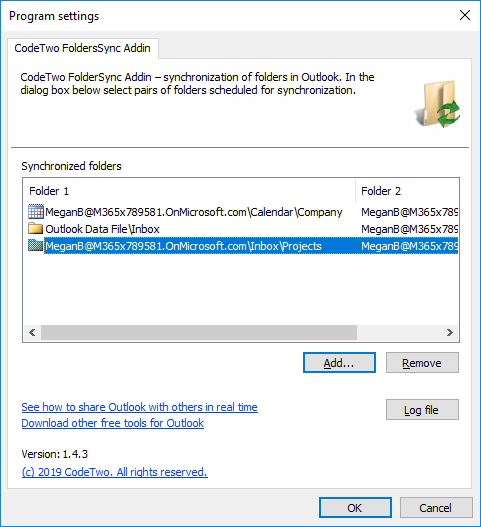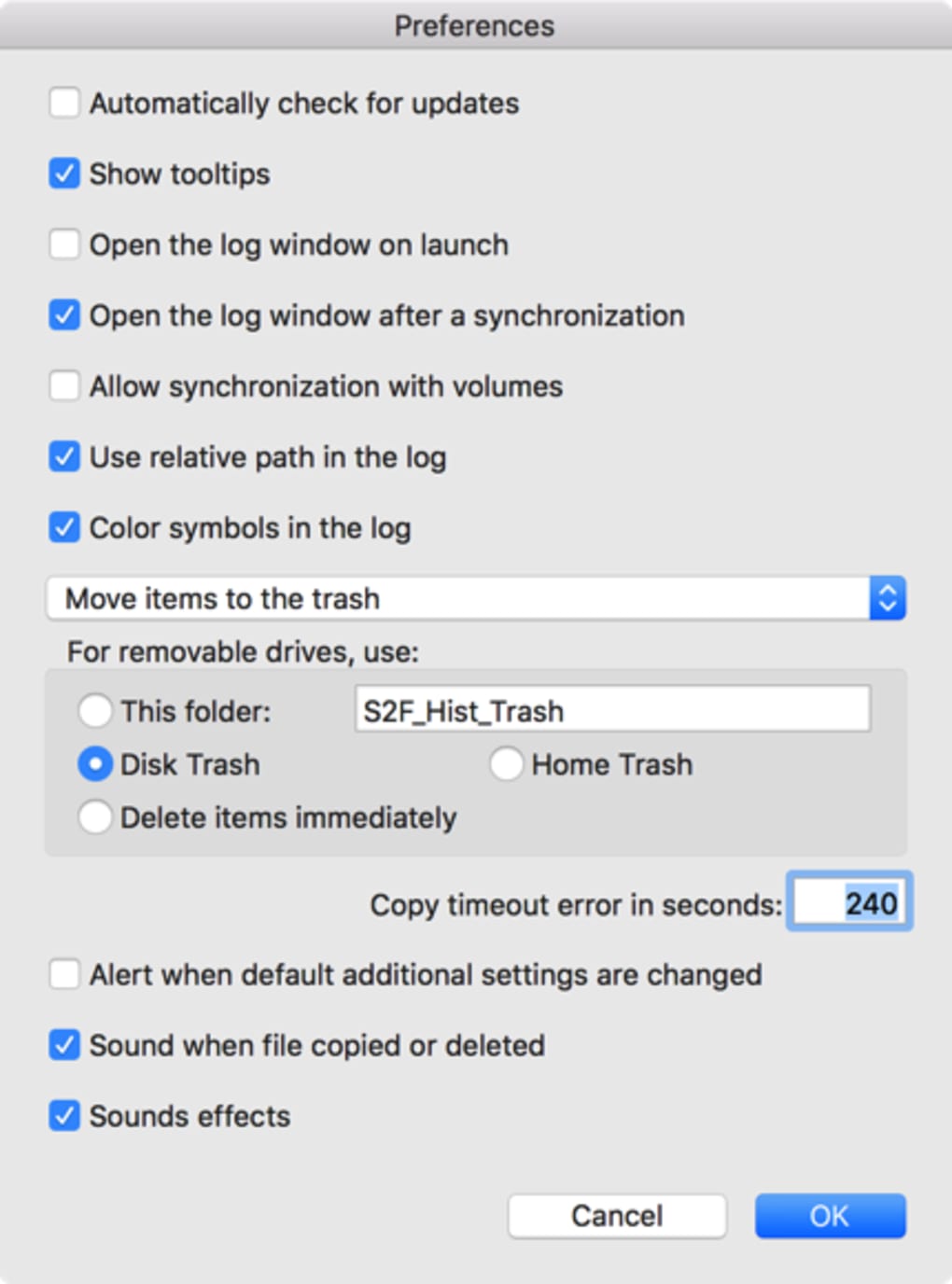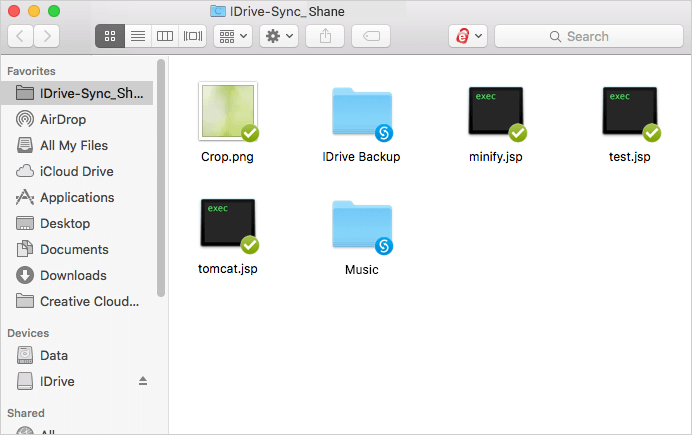Download Sync Folders for macOS 10.8 or later and enjoy it on your Mac. Sync Folders is a free version of the popular Sync Folders Pro utility. The app is an easy-to-use for beginners, has the ability to fine-tune synchronization settings for the most exacting professionals. The 2.15.2 version of Folder Sync 2 for Mac is provided as a free download on our website. The software belongs to System Tools. This free software for Mac OS X was originally produced by Destek Ltd. Our antivirus scan shows that this Mac download is clean.
- How To Sync Two Folders
- Sync Two Folders Mac Download Free
- Sync Two Folders Mac Download Free
- Mac Sync Folders Automatically
- Mac Synchronize Folders
- Sync Two Folders Mac Download App
- To sync file sharing, click on “Add new pair.”. Choose which files you want synced, one on the Mac and one on your other device. Then you can choose in which direction you want your sync done. Click “Add new pair” to add the selected folders. Press “Apply” and then “Sync” to the syncing.
- It works under GNU/Linux, Mac OS, Solaris and several versions of BSD. There is also an official Syncthing Android app available for those who wants to sync files between mobile devices and computers. Heads Up: Please note that Syncthing doesn't support local synchronization. Meaning - you can't sync files between folders on the same system.
- Install GoodSync. Download and install on Windows, MAC, LINUX, or NAS platforms. Access advanced GoodSync features free for the first 30 days. Create your first GoodSync job. Create and name your first GoodSync job, and select between one-way backup or two-way synchronization.
There are two basic ways that you, as an administrator, can deploy the OneDrive sync app to Mac users in your organization:
Have users install and set up the OneDrive sync app themselves by following the instructions in Sync files with OneDrive on Mac OS X. To install the OneDrive sync app for Mac, a user has to be an administrator on the Mac or know an administrator account name and password.
Download the installer package file to your local network, and then use your software distribution tools to deploy the app to your users. By using a software distribution tool, you have more control over the deployment, including which users get the sync app and when. The OneDrive sync app for Mac uses the Apple Installer technology for installation. This means you can continue to use the software distribution tools that you normally use to deploy software to Mac users. You can use Microsoft Intune. Other common tools are Jamf Pro, Munki, and AutoPkg. You can also use Apple Remote Desktop and AppleScript.
Manage OneDrive settings on macOS using property list (Plist) files
Download Sync Folders for macOS 10.8 or later and enjoy it on your Mac. Sync Folders is a free version of the popular Sync Folders Pro utility. The app is an easy-to-use for beginners, has the ability to fine-tune synchronization settings for the most exacting professionals. The Backup and Sync app comes with a script and running it sometimes fixes many issues with the app on your Mac. You can access it by revealing the content of the app package. Open the Applications folder using Finder and find the Backup and Sync from Google app. Folder Mac#1 - (other external drive or network resource) - Folder Mac#2. For the above item 1 installation of Sync Folders Pro is only necessary on Mac#1 only. For the above items 2, 3, 4 Sync Folders Pro should be installed on both Mac#1 and Mac#2. To sync Mac and PC using the following schema: Folder Mac - Network Folder PC.
After the OneDrive sync app for Mac is installed, users can configure settings for the app. These settings are called preferences. As an administrator, you might want to provide users in your organization with a standard set of preferences. Preferences for the OneDrive sync app for Mac are stored in preference files. These files are often referred to as .plist files.
| Standalone | Mac App Store | |
|---|---|---|
| PList Location | ~/Library/Preferences/com.microsoft.OneDrive.plist | ~/Library/Containers/com.microsoft.OneDrive-mac/Data/Library/Preferences/com.microsoft.OneDrive-mac.plist |
| Domain | com.microsoft.OneDrive | com.microsoft.OneDrive-mac |
Configure sync app settings
Configure the settings on macOS as follows:
Quit the OneDrive app.
Define the settings you want to change by creating a Plist file with the values, or use a script to set the default values.
Deploy the settings onto the local computer.
Refresh the preferences cache.
On the next start of OneDrive, the new settings will be picked up.
Overview of settings
Use the following keys to preconfigure or change settings for your users. The keys are the same whether you run the standalone or Mac App Store edition of the sync app, but the Plist file name and domain name will be different. When you apply the settings, ensure that you target the appropriate domain depending on the edition of the sync app.
List of settings
AllowTenantList
Sync Folders Automatically
This setting prevents the users from uploading files to other organizations by specifying a list of allowed tenant IDs. If you enable this setting, the user gets an error if they attempt to add an account from an organization that is not in the allowed tenants list. If the user has already added the account, the files stop syncing. This setting takes priority over Block syncing OneDrive accounts for specific organizations setting. Do NOT enable both settings at the same time.
The parameter for the AllowTenantList key is TenantID and its value is a string which determines the tenants for whom the Allow Tenant setting is applicable. For the setting to be complete, this parameter also requires a boolean value to be set to it. If the boolean value is set to True, the tenant is allowed to sync.
The example for this setting in the .plist file is:
<key>AllowTenantList</key>
<array>
<dict>
<key>TenantId1</key>
<Bool>True</Bool>
<key>TenantId2</key>
<Bool>True</Bool>
</dict>
</array>
AutomaticUploadBandwidthPercentage
This setting enables the sync app to automatically set the amount of bandwidth that can be used for uploading files, based on available bandwidth.
To enable this setting, you must define a number between 1 and 99 which determines the percentage of bandwidth the sync app can use out of the total available bandwidth.
The example for this setting in the .plist file is:
<key>AutomaticUploadBandwidthPercentage</key>
<int>(Bandwidth)</int>
BlockExternalSync
This setting prevents the sync app from syncing libraries and folders shared from other organizations.
Sync Folders Mac App Mac
If you set the setting's value to True, the users are prevented from syncing OneDrive and SharePoint libraries and folders with organizations other than the user's own organization. Set this value to False or do not enable the setting to allow the OneDrive and SharePoint files to be synced with other organizations also.
The example for this setting in the .plist file is:
<key>BlockExternalSync</key>
<(Bool)/>
How To Sync Two Folders
BlockTenantList
This setting prevents the users from uploading files to organizations that are included in the blocked tenant IDs list that is specified.
If you enable this setting, the users get an error if they attempt to add an account from an organization that is blocked. If a user has already added an account for a blocked organization, the files stop syncing. This setting does NOT work if you have Allow syncing OneDrive accounts for only specific organizations setting enabled. Do NOT enable both settings at the same time.
You must enable this setting by defining IDs for the TenantID parameter which determines the tenants to whom the block tenant setting is applicable. You must also set the boolean value to True for the ID of every tenant you want to prevent from syncing with the OneDrive and SharePoint files and folders.
Note: In the list, inclusion of the tenant ID alone does not suffice. It is mandatory to set the boolean value to True for the ID of each tenant who is to be blocked.
The example for this setting in the .plist file is:
<key>BlockTenantList</key>
<array>
<dict>
<key>TenantId1</key>
<Bool>True</Bool>
<key>TenantId2</key>
<Bool>True</Bool>
</dict>
</array>
DefaultFolderLocation
This setting specifies the default location of the OneDrive folder for each organization.

The parameters are TenantID and DefaultFolderPath.The TenantID value is a string that determines the tenants to whom the default folder location setting is applicable.The DefaultFolderPath value is a string that specifies the default location of the folder.
Sync Two Folders Mac Download Free
The following are the conditions governing the default folder location:-Mac app store: The path must already exist when the user is setting up the sync app.-Standalone: The path will be created (if it doesn't already exist) after the user sets up the sync app. Only with the Standalone sync app you can prevent users from changing the location.
The example for this setting in the .plist file is:
<key>DefaultFolder</key>
<array>
<dict>
<key>Path</key>
<string>(DefaultFolderPath)</string>
<key>TenantId</key>
<string>(TenantID)</string>
</dict>
</array>
DisableHydrationToast
This setting prevents toasts from appearing when applications cause file contents to be downloaded.
If you set the setting's value to True, toasts do not appear when applications trigger the download of file contents.
The example for this setting in the .plist file is:
<key>DisableHydrationToast</key>
<(Bool)/>
DisablePersonalSync
This setting blocks users from signing in and syncing files in personal OneDrive accounts. If this setting has been configured after a user has set up sync with a personal account, the user gets signed out.
If you set the setting's value to True, the users are prevented from adding or syncing personal accounts.
The example for this setting in the .plist file is:
<key>DisablePersonalSync</key>
<(Bool)/>
DisableTutorial
This setting prevents the tutorial from being shown to the users after they set up OneDrive.

If you set this setting's value to True, the tutorial is blocked from being shown to the users after they set up the OneDrive.
The example for this setting in the .plist file is:
<key>DisableTutorial</key>
<(Bool)/>
DownloadBandwidthLimited
This setting sets the maximum download throughput rate in kilobytes (KB)/sec for computers running the OneDrive sync app.
You must set this setting's value to an integer between 50 KB/sec and the maximum rate is 100,000 KB/sec which determines the download throughput in KB/sec which the sync app can use.
The example for this setting in the .plist file is:
<key>DownloadBandwidthLimited</key>
<int>(Download Throughput Rate in KB/sec)</int>
FilesOnDemandEnabled
Sync Two Folders Mac Download Free
This setting specifies whether Files On-Demand is enabled.
If you don't set this setting, Files On-Demand will be enabled automatically as we roll out the feature, and users can turn the setting on or off.
If you set this setting to True, FilesOnDemand is enabled and the users who set up the sync app can view the online-only files, by default.
If you set this setting to False, FilesOnDemand is disabled and the users won't be able to turn it on.
The example for this setting in the .plist file is:
<key>FilesOnDemandEnabled</key>
<(Bool)/>
HideDockIcon
This setting specifies whether a dock icon for OneDrive is shown.
If you set this setting's value to True, the OneDrive dock icon is hidden even if the app is running.
The example for this setting in the .plist file is:
<key>HideDockIcon</key>
<(Bool)/>
HydrationDisallowedApps
This setting prevents apps from automatically downloading online-only files. You can use this setting to lock down apps that don't work correctly with your deployment of Files On-Demand.
To enable this setting, you must define a string in JSON format as described below:[{'ApplicationId':'appId','MaxBundleVersion':'1.1','MaxBuildVersion':'1.0'}]
'appID' can be either the BSD process name or the bundle display name. 'MaxBuildVersion' denotes the maximum build version of the app that will be blocked. 'MaxBundleVersion' denotes the maximum bundle version of the app that will be blocked.
The example for this setting in the .plist file is:
<key>HydrationDisallowedApps </key>
<string> [{'ApplicationId':'appId','MaxBundleVersion':'1.1','MaxBuildVersion':'1.0'}, {'ApplicationId':'appId2','MaxBundleVersion':'3.2','MaxBuildVersion':'2.0'}]</string>
<(Bool)/>
OpenAtLogin
This setting specifies whether OneDrive starts automatically when the user logs in.
If you set this setting's value to True, OneDrive starts automatically when the user logs in on Mac.
The example for this setting in the .plist file is:
<key>OpenAtLogin</key>
<(Bool)/>
SharePointOnPremFrontDoorUrl
This setting specifies the SharePoint Server 2019 on-premises URL that the OneDrive sync app must try to authenticate and sync against.
To enable this setting, you must define a string containing the URL of the on-premises SharePoint Server.
The example for this setting in the .plist file is:
<key>SharePointOnPremFrontDoorUrl</key>
<string>https://Contoso.SharePoint.com</string>
SharePointOnPremPrioritizationPolicy
This setting determines whether or not the client should set up sync for SharePoint Server or SharePoint in Microsoft 365 first during the first-run scenario when the email is the same for both SharePoint Server on-premises and SharePoint in Microsoft 365 in a hybrid scenario.
If you set this setting's value to 1, it is an indication that OneDrive should set up SharePoint Server on-premises first, followed by SharePoint in Microsoft 365.
The example for this setting in the .plist file is:
<key>SharePointOnPremPrioritizationPolicy</key>
<int>(0 or 1)</int>

SharePointOnPremTenantName
This setting enables you to specify the name of the folder created for syncing the SharePoint Server 2019 files specified in the Front Door URL.

If this setting is enabled, you can specify a TenantName which is the name the folder will use in the following convention:
OneDrive – TenantName (specified by you)
TenantName (specified by you)
If you do not specify any TenantName, the folder will use the first segment of the FrontDoorURL as the its name. For example, https://Contoso.SharePoint.com will use Contoso as the Tenant Name in the following convention:
OneDrive – Contoso
Contoso
The example for this setting in the .plist file is:
<key>SharePointOnPremTenantName</key>
<string>Contoso</string>
UploadBandwidthLimited
This setting defines the maximum upload throughput rate in KB/sec for computers running the OneDrive sync app.
To enable this setting, set a value between 50 and 100,000 which is the upload throughput rate the sync app can use.
The example for this setting in the .plist file is:
<key>UploadBandwidthLimited</key>
<int>(Upload Throughput Rate in KB/sec)</int>
You can also configure the OneDrive Standalone sync app to receive delayed updates.
| PList Location | Domain |
|---|---|
| ~/Library/Preferences/com.microsoft.OneDriveUpdater.plist | com.microsoft.OneDriveUpdater |
| Setting | Description | Parameters | Example Plist Entry |
|---|---|---|---|
| Tier | Defines the update ring for the computer | UpdateRing (String): This parameter has two different values. Production - The default update ring for OneDrive updates. Insiders - This update ring receives updates that are 'pre-production' and that allow you to play with features before they are released. Note that builds from this ring may be less stable. Enterprise - This update ring (now called 'Deferred') receives updates after they have been rolled out through the Production ring. It also lets you control the deployment of updates. For more information about the update rings and the procedure used by the sync app for checking for updates, see The OneDrive sync app update process. | <key>Tier</key> <string>(UpdateRing)</string> |
Sync Folders Pro
for macOS 11 - 10.8

Key Features:
- Bootable backup on an external drive (SSD, HDD). macOS Big Sur, macOS Catalina compatibility.
- Bidirectional synchronization, one-way synchronization, mirroring backup.
- Powerful preview mode. Ability change file operations before sync. 'Line by Line' comparison.
- Automatic scheduled synchronization.
- Synchronization any number of pair folders at same time.
How to get started for Beginners
Solutions For Synchronizing Folders Macworld
- Select sync folders.
- Select sync mode.
- Click 'Sync Current Task' button and your folders will be synchronized!
- Do not worry about other settings, they are set to the recommended ones.
For the most exacting professionals
Sync Two Folders Mac
Create a bootable clone of your hard drive and you can use it if your main drive is crashed.
Sync Folders Pro is perfect for backups to external storage devices including:
USB, memory cards, disks on remote computers within your network, folders on Cloud services (Dropbox, etc.) With each re-backup, the app finds and copies only new files and new file versions, thereby reducing backup time and extending the life of your storage devices.
Microsoft Folder Sync Tool
The app can synchronize multiple pairs of folders at the same time 'on the fly' using our 'REAL TIME SYNC' technology, on a schedule or manually. The Sync Folders Pro also provides robust tools to filter files and folders so that you sync exactly what you want.
Mac Sync Folders Automatically
Do you have terabytes (TB) of data to sync? No problem! Sync Folders Pro has been optimized to work with extremely large number of files. Sit back and relax, your data is being automatically synced!
Mac Synchronize Folders
Sync Folder Pro
Sync Two Folders Mac Download App
- 9 synchronization modes.
- 6 file comparison modes allow to synchronize files on the storage devices with different file systems (OS X, FAT32, etc.).
- The ability to automatically connect network folders before synchronization and disconnect network folders after synchronization.
- Protection for unauthorized disconnect storage devices (folders) during synchronization.
- Saving the last/all versions of files to be deleted. Using this mode, you can always restore deleted files, even if folders have synchronized several times.
- Quick view the latest changes in synchronized folders.
- Ability to log events. You can filter events by type, task, status. Ability to export the event log to an external file.
- Ability to send event log by e-mail in case of synchronization errors.
- Synchronization of subfolder attributes.